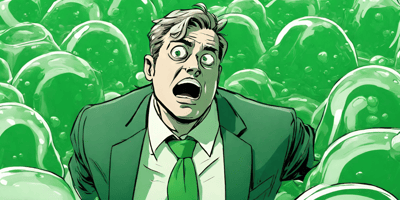A few months ago, I was talking to a very astute person who said, “you can’t change what people...
15 years ago, I wrote down my unconventional "principles of innovation" - I just found them again.
 I was recently chatting with my boss (also a former CPG marketer) about innovation. I remembered that I had once written down a set of "Innovation Principles." Amazingly, I found the list. This is from about 15 years ago when I was working in innovation at The Hershey Company. The list seems fairly straightforward and perhaps obvious. Except, the reason I wrote these principles down was that I was not seeing them put into practice.
I was recently chatting with my boss (also a former CPG marketer) about innovation. I remembered that I had once written down a set of "Innovation Principles." Amazingly, I found the list. This is from about 15 years ago when I was working in innovation at The Hershey Company. The list seems fairly straightforward and perhaps obvious. Except, the reason I wrote these principles down was that I was not seeing them put into practice.
I had this apparently "unconventional" belief that the key to creating breakthrough ideas was first filling the pipeline with the not-so-breakthrough and not-so-exciting ideas, actually developing them to be launch-ready before working on the cool stuff. I thought that was the point - that without a pipeline of mediocre ideas "on the shelf," one is stuck throwing money and resources at complex, high risk projects that "cannot fail' - because if they do fail "we've got nothing." I feel like I saw the "we've got nothing" scenario play out many times. Conversely, having the fallback of a pipeline of totally doable (if not totally exciting) ideas "ready to go" seems like it would be very freeing, i.e. it's easier to take big risks when there is a safety net.
So, here's my (mostly) unedited list of innovation principles as written ~15 years ago. It's been a while since I have been in a product innovation role - but perhaps the same problems still persist? Also, I wonder how well these slightly "unconventional" principles would work in practice?
_______________________________________________________________________
8 Principles of Innovation:
1. Strategy: “Clear & Simple Direction”
A good strategy maps out where you want to go, and - more importantly – where not to go.
- Does everyone know where we are going?
- Is everyone rowing in the same direction?
2. Realism: “Hopeful Realism NOT fatal optimism”
Recognizing where you’re starting from and creating a step by step plan to get where you want to end up is the way to succeed. Acting like you’re already there is a sure path right back to where you started (or worse).
- Do we have the plan to get us where we want to go, not just the process for when we get there?
3. Pipeline: “The source of successful innovation is a full pipeline”
Not having a full pipeline leads to a vicious cycle of project focus – which leads to small, "dumbed down" low risk launches or disastrously huge, costly market failures. On the other hand, having a pipeline covers a lot of sins.
- Do we have a pipeline?
- If not, do we have a mechanism to build one?
- If yes, do we have a process to maintain one?
4. Holes: “Filling holes is the first priority”
Breakthrough innovation is impossible if there are holes in the business … when there are holes, all activities will get sucked into them.
- Do we have any calendar holes?
- Do we have any retail holes (price points, promotional, seasonal)?
- Do we have any competitive holes – weaknesses or missing offerings?
- Do we have any consumer holes – trends that will impact growth?
5. Barriers: “Breakthrough innovation comes from overcoming barriers”
Making a better mousetrap won’t accelerate growth … you have to overcome a barrier that stops people from purchasing
- Are we set up to address barriers rather than filling "white space"?
6. Risk: “The worst case scenario needs to be acceptable”
If the worst case scenario is “we’ve got nothing,” then the pressure to mitigate risk by suboptimizing will overwhelm the drive to get it right.
Building the pipeline from close-in first and then to further-out creates low-risk options to fill holes/gaps that will inevitably arise.
- Do we have an acceptable “worst case scenario”?
7. Fast Failure: “Failing fast leads to stronger ideas and fewer wasted resources”
To solve an innovation problem:
- Clearly identify the parameters
- Identify a broad range of potential solutions
- Eliminate infeasible solutions quickly
- Seek to make simple solutions work before more complex
- Include broad participation (sales, engineering, R&D) early
Do we have a process that fails unacceptable solutions quickly to avoid wasted resources?
8. Limited Resources: “Projects should be fully resourced ‘vertically’ according to priority”
Fully resource top priority projects – when you run out of resources, draw a line … STOP all work on below the line projects. As new work arises, re-prioritize and allocate resources accordingly. If resources are insufficient for all necessary projects – get more resources (if possible), but DO NOT stretch resources further.
- Do we have a mechanism for prioritizing projects?
- Do we have a mechanism communicating priorities?
- Do we have a mechanism for allocating resources “vertically”?



